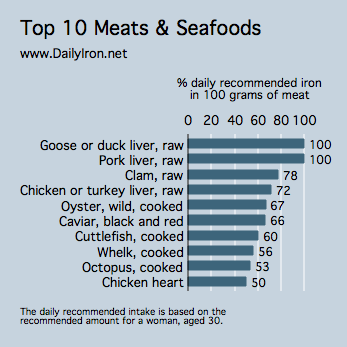 Iron is abundant in meat, particularly in red meat and processed meat products (such as sausage) that contain red meat. People who consume red meat regularly tend not to develop iron deficiency in the first place because of the high iron content in the food.
Iron is abundant in meat, particularly in red meat and processed meat products (such as sausage) that contain red meat. People who consume red meat regularly tend not to develop iron deficiency in the first place because of the high iron content in the food.
However, meat has an additional benefit over plant-based sources of iron: meat contains a different form of iron, heme iron, which is better absorbed by the body. Heme iron is more readily absorbed and is not quite as affected by iron inhibitors, such as phytic acid or the polypenols in black tea, as are plant-based foods. Certainly, heme iron is a bit better absorbed without these inhibitors, but nutritionists get far less concerned about the effect of phytic acid on heme iron.
In fact, researchers believe that the heme iron in meat may help improve the absorption of non-heme iron in plant-based foods in the diet (Reddy et al. J of Nutrition 2006 v136 p576-581).
As you shop for iron-rich meats, consider the Top Ten meat list. While red meat as a class is quite high in iron, notice some unusual suspects in the Top Ten that can add variety to your diet. An assortment of livers tops the list, but they may not be a top choice for everyone because of their strong flavor. Clam, oyster, and caviar are more commonly available foods and notably high in iron. While the foods in the list note whether the item is “raw” or “cooked,” iron is not damaged by cooking and, in fact, cooking may reduce iron inhibitors (particularly in plant-based foods) and improve your absorption of iron.
Common meats
For the iron content of various meats, click on the links below.
Read more about iron rich meats and other foods at the iron rich food website. Check out our iron rich foods tips pages.